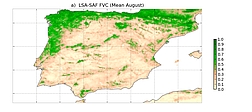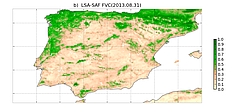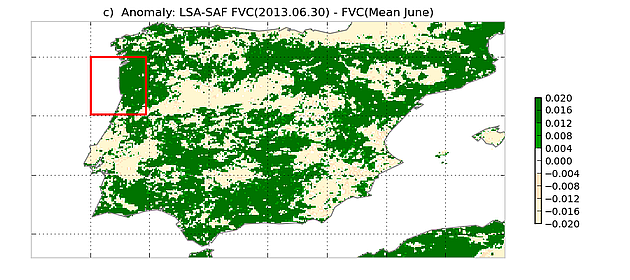Chapter IV: Consequences of Caramulo Fires
Table of Contents
- Chapter IV: Consequences of Caramulo Fires
- Introduction
- Signature on the vegetation
- Carbon emissions to the atmosphere
Introduction
As mentioned in the introduction the Caramulo fires had severe ecological, social and economic consequences and many of them will be felt for several decades. However, some of the short term consequences of forest fires have signatures in the vegetation and in the carbon release to the atmosphere which can be monitored by satellites.
Signature on the vegetation
The first major impact is felt on the vegetation. In fact, unlike June, the August FVC (Figure 9a vs. Figure 9b) showed negative anomalies in the Caramulo area relatively to the mean (Figure 9c) which indicates that at the end of August 2013 there was a deficit of fraction of vegetation in comparison to the mean August conditions.
Use the slider on Figure 9 c) to compare the diferences between Figure 9 c) (The difference between the mean value for August and those of August 31st 2013) and Figure 5 c) (The difference between the mean value for June and those of June th 2013)




| Figure 9: LSASAF FVC values for (a) August on average, (b) 31 August 2013, and (c) the difference between (a) and (b). Greenish values signify thicker vegetation cover than the monthly mean while yellowish tones mark below-average values. |
Carbon emissions to the atmosphere
The second immediate major impact can be estimated by the fire gases emissions to the atmosphere. The Fire Radiative Power of a fire pixel is measured in megawatts and represents the amount of radiant heat energy liberated per unit time from the burning contained in a pixel. This FRP-PIXEL value is related to the rate at which fuel is being consumed (Wooster et al., 2005) and the energy release is a direct result of the combustion process, whereby carbon-based fuel is oxidised as CO2 with the release of a certain "heat yield", a fraction of which is emitted as electromagnetic radiation that can be measured with remote sensing instrumentation. The temporal integration of the FRP measured over the lifetime of the fire provides a measure of the total Fire Radiative Energy (FRE), which is proportional to the total fuel mass combusted. Simple linear relationships linking FRP, FRE and fuel consumption were first demonstrated in detail by Wooster et al. (2005).
| Fuel biomass combusted (kg) = 0.368(± 0.015) X Fire Radiative Energy (MJ) | (1) |
An estimation of the fuel biomass consumption during the Caramulo fires can be made in the following manner: The FRPPIXEL product integrated over space and over the entire fire event (Fire Radiative Energy) is used on equation (1) and the fuel of biomass combusted is estimated. Once computed the biomass combusted, it can be simply multiplied by the fraction of carbon contained in the fuel - usually assumed to be ~0.47 - to estimate the total carbon release. Using this simple approach it was conclude that during the Caramulo fires more than
1770 ton of Carbon were released to the atmosphere.